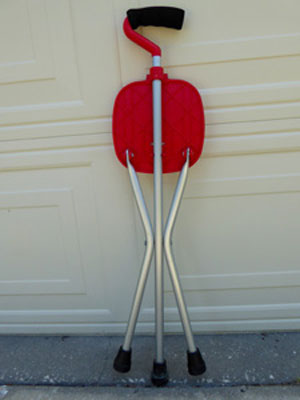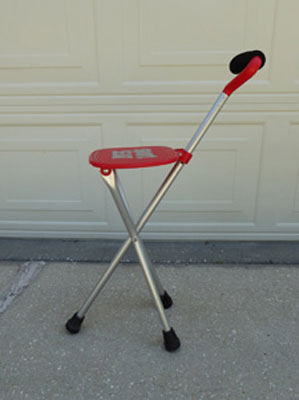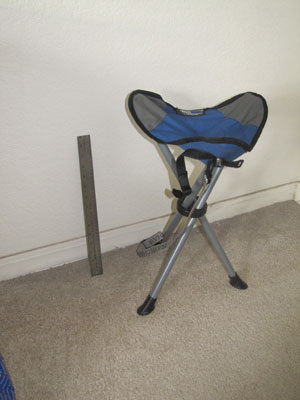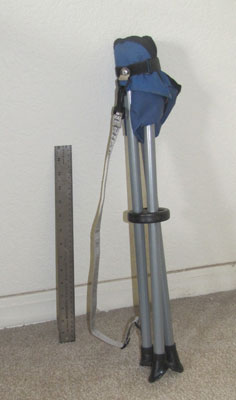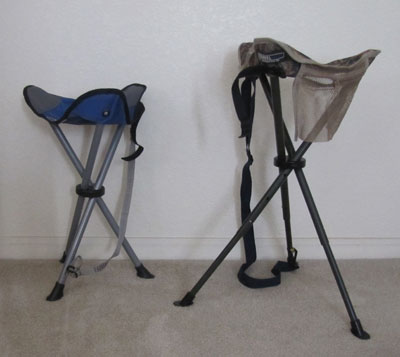Travel Solutions for Stamina Issues. This month, recommended cane seats. (1 of 2)
In the December 2014 and January 2015 issues, ITN printed an information request from Diane Robbins of Penfield, New York: “When sightseeing, my husband does well for a while, but after about an hour or so of walking or being on his feet, he needs to rest for a few minutes. We nixed a trip to Rome because of feedback that visiting the Vatican can take hours, with no place to sit. I would love to have some feedback from other travelers who have stamina issues. I’m curious about travelers who take those canes that open into seats. Are they easy to use and do people feel secure sitting on them? Can anyone recommend a travel company that travels at a slower pace, one that offers trips with few (or no) one-night stays and walking tours that don’t feel like you’re taking a forced march?”
Many subscribers wrote to help Diane. Many replied with information about cane seats and similar aids. We’re printing those letters this month. In next month’s issue, we’ll print responses with general advice and a few recommendations of companies offering trips that are less taxing.
I have severe osteoarthritis in my lower back, and, while I can walk for a couple of miles, I cannot stand still for more than five minutes at a time. Since I always take tours, this causes a big problem if the guide pauses to talk where there is no place for me to sit down or lean against something. Because of this, I have been using a cane seat for several years. I wouldn’t travel without it!
It is easy to open. Push on the RIGID seat and the three metal legs open out and you can sit on the seat. It’s certainly stable as long as you pay attention when first sitting down. I feel very secure on it.
When it’s folded up, I use it as a cane (which I don’t really need, but it steadies me if I’m walking on rough or uneven ground or up a hill). It also goes through airport security without being counted as an extra carry-on.
This cane seat, which I bought at Walgreens (www.walgreens.com), is about 34 inches long when closed, but it can be adjusted to several inches longer.
I don’t often see them at Walgreens, but I did see one listed in the Walter Drake catalog (www.wdrake.com/buy-folding-cane-seat-302914) and another in the Magellan’s catalog (www.magellans.com/Search.aspx?txtSearch=cane%20seat), although I don’t think either of those is adjustable in height.
I’ll be glad to answer any questions at newhitman@neb.rr.com.
Nancy Whitman, Lincoln, NE
I sympathize with Diane’s husband’s problem. I can walk fairly well for a good bit of time but have a very difficult time standing around. It is actually painful.
My husband and I go on a lot of art tours, and I have noticed other people using those folding chairs called cane seats that act as canes as well as seats; Amazon.com has them. Those people were often the only ones in the room who were comfortable, except those of us who were lucky enough to have gotten a seat on one of the benches.
So I bought a cane seat. It has three aluminum legs and a PLASTIC seat. I’ve taken it with me only one time, and it was really nice to have.
Was it comfortable? It was certainly adequate for a short rest, but the seat is quite small, and, for safety, you have to sit on it “backwards.” I don’t think it would work for a very large person.
Being comfortable sitting down for a few minutes when on a walking tour is not going to solve Diane’s husband’s problem, however, because the group will be way ahead by the time he has recuperated.
There is a website called Disabled travelers.com that lists a wide variety of tour operators, including those offering tours specifically for slow walkers. It’s definitely worth looking into.
Beth DeAtley, Piedmont, CA
I am 78 years old and have stamina issues when it comes to walking long distances. I have used a cane seat on my travels with much success.
Mine has three legs, but they fold together so that when you walk, it’s just like using a regular cane. The round, flat seat is hard PLASTIC.
Cane seats are easy to use and secure. My only problem is I tend to forget them, leaving them behind. However, they are inexpensive — under $30 on Amazon.com — so I just buy another one.
I have inquired about using portable scooters. My daughter has cerebral palsy and uses them on easy trips, such as cruises. The crew is usually very good about loading and unloading it in ports. However, they are not good on walking tours in countries with cobblestone streets or streets with no curb cuts or on stairs.
Keith Klarin, Palm City, FL
Google “sling canes” and you’ll get lots of retail-outlet hits. The sling cane my wife and I use carries the brand name Drive (Drive Medical, Port Washington, NY; 866/694-5085, www.drivemedical.com/b2b/index.php).
My wife has used one for about 10 years and likes it as a seat, although she finds it slightly cumbersome to carry along (though it can function as a walking cane for those who need such).
She purchased the sling cane after recovering from a broken ankle in 2007, and she used it on a trip to Japan in 2008, on a train trip in South Africa and another in Serbia and Bulgaria as well as on a trip to Iceland.
This flexible FABRIC sling cane seat is designed to be straddled like a saddle rather than sat in as, say, a playground-swing seat (which it looks like). The recommended posture could be difficult for a woman wearing a skirt, but the result is actually quite a bit more stable, whereas it would be fairly easy for a person to fall over backward if sitting with the device’s two closely spaced legs on each side.
A word of warning — my wife’s sling cane came apart after many years (but not many hours) of use and dropped her on the sidewalk. Luckily, she wasn’t hurt. We found that the screws going into the tubular cross members connected only into plastic bushings, and eventually one of these had “fatigued” until it allowed the screw to pull out.
We were on a trip of Andalucía in Sevilla, Spain, with Untours in 2010 when it happened. For about €10 in a local hardware store, I bought a length of threaded rod (about ¼ inch in size but metric, of course) plus a handful of nuts, washers and jam nuts, a hacksaw and a wrench. (My travel Leatherman provided the second wrench that was needed.)
It took about an hour to replace all eight short bolts and plastic bushings with four metal rods extending clear across from side to side. I would recommend that all owners of these devices do this.
One side of the sling cane now has both the regular nuts used to snug up the connection and then the jam nuts on top of them. The other side has only the jam nuts. The jam nuts provide a smoother finish and should not become loose on their own.
Hint — when sawing off a threaded rod, put a nut on the rod before cutting it, then remove the nut to “chase” the threads, smoothing out burrs left from the saw.
Irv Smith, Missouri City, TX
I recommend using a cane seat with adjustable-height legs. I just saw one listed on AliMed (Dedham, MA; 800/225-2610, www.alimed.com [type “cane seat” in the search box]), item No. 713325, for $50.75 plus shipping.
I have no walking or stamina issues, thankfully, but use one as a harp stool. It’s sturdy and yet lightweight (less than two pounds), easy to move from place to place. It has a SOLID oval seat supported by three legs.
I can attest that it is not uncomfortable, as I sit on it for up to three hours at a time while playing background music in a local restaurant. The adjustable height is a must!
Sharon Affeltranger, Pacifica, CA
About 10 years ago my husband and I were in Rome when he had an issue with his back, so we bought a cane seat for him to use. (Before that, we occasionally used one that looked like a BICYCLE SEAT on a stick, which I guess golfers use.) After we left the Italy cane seat on a train the next year, we bought another from Amazon.com, listed as the “Drive Medical Deluxe Folding Cane Seat.”
This one is 3-legged and sturdy. It’s seat is more like a bicycle seat but much more comfortable. It’s from Drive Medical (866/694-5085, www.drivemedical.com/b2b/index.php). On Amazon, it currently costs $22.99 and is worth every penny and more.
We both use it when we travel, even to go to a local museum. It’s great when waiting in an airport check-in line. We usually take only one cane seat and share back and forth. Regarding who gets to use it, we just ask the other one, “Do you want it now?” Or, on a walking tour, we give each other a look.
The cane seat is wonderful. (I even ordered one for an Italian friend in Verona and shipped it to her for Christmas.)
Just remember to follow the instructions and sit on it “horse style,” with the cane sticking up between your legs. (If it’s facing away, you’ll fall on your butt.)
By the way, we had to replace the bolt in the original version we bought in Italy, since it wasn’t tempered steel and bent under constant use under 180 pounds. To be safe, my husband bought a tempered-steel replacement bolt at a hardware store and replaced it. (We didn’t take a chance with the Drive Medical models we got from Amazon; we just replaced the bolts immediately to be safe.)
Sandra Spector, Palo Alto, CA
I have used the cane that opens into a seat and it works very well.
The device has a solid PLASTIC triangular seat atop a tripod with a cane handle attached. It either folds flat, for when you’re walking, or opens into a seat when needed.
The seat is secure, especially if you’re wearing pants, because it is best to spread your legs around it and hold the handle in front.
I found it helped immensely to sit for a few minutes to relax the back and catch a breath, especially in museums or at archaeological sites, which may not have seating.
I bought mine at the mail-order company Magellan’s (888/450-7715, www.magellans.com), where it’s listed as a Sport Seat, available for $32.50 plus.
The only problem is it’s easy to forget and leave it behind, as I once did on an airplane.
Linda Huetinck, Alhambra, CA
Amazon.com has lots of travel cane seat products. Read the reviews carefully regarding sizes and ease of use, not for the personal “stories” of the reviewers. There are many options, sizes, weight limits and prices.
I chose the 3-legged Portable Folding Walking Stick Cane (http://amzn.com/B00C52N06C), which cost $20.50 because it was small, simple and well made. From reviews, I also knew its limits.
The cane has a set height of 32 inches, and if I were any taller than 5'6", it would be a problem.
I use the seat on somewhat uneven ground carefully. The handle goes IN FRONT, between your legs (a problem for someone wearing a dress?). The seat is flexible FABRIC, much more comfortable for longer sittings.
On this model and others, one may add to the padding and size of the handle. I placed bulkier rubber, nonskid tips on all the feet, and I added a wrist strap by poking a hole in the handle cap.
I like to tinker with things, so I actually added one inch of doweling to two of the legs and 1½ inches to the third (handle) leg. This made the seat higher, with the cane seat broader based (more stable), and when I walk, only the long leg hits the ground.
I carry a couple of Velcro-type, hook-and-loop-fastener straps, which allows me to secure the three legs together at the base. With the legs strapped together and only a single leg hitting the ground when I walk, the clanking is reduced and it is much quieter (think museum).
The Velcro straps also allow me to attach the cane seat to my roller suitcase handle for when I’m pulling my bag up subway stairs and I need my “free” hand on a railing.
Adjustable-height cane seats would be better suited for larger people. (Adjustable cane seats are bulkier and weigh more.) It can be hard maneuvering onto and out of any seat, especially if it is “low.” Some cane seats have hard seats instead of fabric seats; most reviews that I read were against these.
I also had an over-the-shoulder foldable seat, but, with a separate cane, that becomes “one more item.” A simple walking stick or cane is simpler and lighter.
I have taken both the stick and the cane seat overseas, “Velcro-ing” one or both to the roller bag. While it’s easier to travel with one “aid,” at times someone may need both, requiring another to carry one’s luggage.
By far, most people recognize, allow for and aid “disabled” travelers. It helps to be somewhat in shape and persistent. I have not needed to use the airport carts, which are often slow, wait for more people or require elevators.
David Smith, Portland, OR
I have severe arthritis as well as degenerative joint disease in my lower back and hips. As a result, I need to sit whenever I can while traveling.
I bought my cane with a seat in 2013, and it has been with me on three Overseas Adventure Travel, or OAT (Cambridge, MA; 800/955-1925, www.oattravel.com), tours — including Costa Rica in November 2013 and Morocco in March 2015 — and a Grand Circle Cruise Line (Boston, MA; 800/221-2610, www.gct.com) small-ship cruise to Holland and Belgium in April 2014.
For my needs, the trips were well paced, and as soon as a tour guide started talking, I popped open the seat on my cane and sat.
My cane came from Sport Seats International (Garland, TX; 800/567-1898, 972/485-8300, www.sportseat.com). Their canes have two standard heights, with prices starting at about $30 plus shipping/handling, and they can custom-cut a cane for a small surcharge, as they did for me.
The length could be custom-cut at 2-inch intervals. If the cane seat is to be used as a cane (as opposed to just a handy seat for sporting events), length is important, as any cane user knows. The rule of thumb that I was taught is the handle should come to your wrist as your arm hangs down.
I selected a cane seat with a RIGID square seat in the color I wanted. It has three legs. The middle one is much longer than the others when folded up and has a cane-style handle at the top. This one serves very well as a cane for walking and has the handle in front when you’re seated.
When sitting on the seat, you’re straddling the cane, having opened the three legs into a tripod, which lowers the seat. I’ve never felt insecure while sitting.
I’ve had the legs fitted with rubber cane tips, put a foam cover over the handle and added a wrist strap. I also bought a seat cushion, which I always use, and a carrying case, which I don’t.
When in the position for walking, the cane is well balanced for use. The seat and legs are flat, and the position of the handle ensures they remain parallel to your body.
At about 28 ounces, the Sport Seat is a bit heavier than a regular cane. Still, as a little lady of a certain age, I handle its weight without difficulty. (It did act a bit like a sail once at the Delta Project in the Netherlands, where the wind off the North Sea was quite strong, but it wasn’t a problem.)
I tested its durability (and the persistence of my OAT tour director) when I inadvertently dropped the cane off the top of the fortified hill Masada on my OAT tour of the Holy Land in late 2014. Someone had to rappel down to retrieve it the next day.
I was so happy to get my cane back. It was no worse for having fallen off a cliff and spending the night with its red seat showing and its legs up in the air.
I can also attest to my total satisfaction with OAT and Grand Circle. Their websites detail the difficulty level of each trip.
I use the cane in airports and stow it in the overhead bins on planes. I’ll be happy to share my experiences and can be reached at bedanzig@gmail.com.
Barbara Danzig, Ponte Vedra Beach, FL
In my opinion, those canes with seats are too bulky and are hard to pack. My wife and I found a 3-legged travel seat to more than fit the bill.
The one that we bought first has a seat 18 inches high and cannot be adjusted for height, but it has a strap that makes it easy to carry. This TravelChair Slacker is available from Hayneedle (Omaha, NE; 888/880-4884, www.hayneedle.com/product/thetravelchairslacker.cfm) for $19.99 plus shipping.
It has a steel frame and a triangular, “rubberized” FABRIC seat 11 inches wide. Its weight capacity is 275 pounds. When folded up, it measures 23 by 3 by 3 inches.
Subsequent to that, we found the adjustable version on eBay; the TravelChair Wingshooter is model number 1389DSG*. Each of the legs fixed to the seat has three holes in it for adjusting the height (up to 24 inches). The lower legs each have a spring-loaded ball that locks the leg when assembled. It can support at least 225 pounds.
The original TravelChair would not fit in a carry-on. With the adjustable model, the legs can be removed and it will fit in a carry-on; the longest piece measures 21 inches. The adjustable model doesn’t have a carry strap, but I made one from a couple of cable ties and a strap from another bag. It’s the only one we use now.
The chair weighs only three pounds. I just sling it over my shoulder.
Steve Goch, Santa Paula, CA
*In an online search by ITN, the TravelChair Wingshooter could not be found new, only secondhand.
I have a back problem that allows me to walk but makes it painful for me to stand for prolonged periods, like the amount of time it takes to get through airport check-in and TSA lines.
I bought a Portable Folding Walking Stick Cane on Amazon.com ($29.50 plus shipping/handling) thinking it would be the best way of coping with the problem, and I’ve tried it out a number of times at home.
I must confess, I don’t like it. With three legs and a FABRIC seat that is 1½ feet from the floor, it’s bulkier than a regular cane and weighs a couple of pounds. If I were to use it extensively, I’d add a wrist strap.
Opening the seat is easy, but you must be careful to verify that it is fully open. One time I sat on it and felt the seat collapsing under me! Fortunately, I hadn’t put my full weight on the seat, so I was able to pull myself upright.
My situation is a bit unusual, as I am extremely limber, despite my back problem, so I prefer squatting on a tiny folding camp stool — because of the stool’s compact size — to using the cane seat (the cane seat doesn’t fold). I bought the stool on Amazon.com too; it was listed as the “Coleman Event Stool” for $8.99 plus S&H.
Be aware that it’s tiny! The seat is only 7½ inches from the ground. I simply hang the stool on a shoulder strap, and when I’m not using it, I can fit the stool into my carry-on suitcase.
Jo Thomas, San Mateo, CA
I have the same issue with fatigue while standing in long lines and after too much walking. This is especially true in airports and museums.
I use something called a Flipstick (Cape Canaveral, FL; 888/355-5440, www.flipstick.us). It’s cane-like, with a triangular, BICYCLE-TYPE seat. The back of the seat is molded into the handgrip. It folds, fitting into a waist fanny pack, and is easily stowed once on the plane.
I love it. It is not as good as sitting down in a seat, as one needs to balance, but it is enough to allow me to keep going.
I ordered it online from Amazon (http://amzn.com/B004XM9BEM) for $45.
Joy Alaidarous, Walnut Creek, CA

